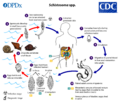Schistosomiasis facts for kids
Quick facts for kids Schistosomiasis |
|
|---|---|
| Synonyms | Bilharzia, snail fever, Katayama fever |
 |
|
| An 11-year-old boy with fluid in his belly and portal hypertension (high blood pressure in the liver) because of schistosomiasis. | |
| Symptoms | Belly pain, diarrhea, bloody poop, blood in the pee |
| Complications | Liver damage, kidney failure, infertility, bladder cancer |
| Causes | Schistosome worms from freshwater snails |
| Diagnostic method | Finding parasite eggs in pee or poop, antibodies in blood |
| Prevention | Access to clean water |
| Medication | Praziquantel |
| Frequency | 252 million (2015) |
| Deaths | 4,400–200,000 |
Schistosomiasis is a parasitic disease caused by tiny worms called Schistosoma. These worms are a type of Trematode, also known as flukes. This disease was once called Bilharzia. The worms need freshwater snails to complete part of their life cycle.
Contents
What is Schistosomiasis?
Schistosomiasis is a sickness caused by tiny worms that live inside people. These worms are called Schistosoma. They are very small, like a type of flatworm. The disease is also known as "snail fever" because snails play a big part in how people get sick.
How Do People Get Schistosomiasis?
People get schistosomiasis when their skin touches fresh water that has tiny worm larvae. These larvae are released from infected snails. The snails live in lakes, rivers, and ponds in many parts of the world.
- The tiny worms enter the body through the skin.
- Once inside, they travel to blood vessels.
- They grow into adult worms and lay eggs.
- These eggs can get stuck in different parts of the body, like the liver, bladder, or intestines.
- The eggs cause the body to react, leading to sickness.
- If an infected person pees or poops in fresh water, the eggs can hatch.
- The hatched eggs then infect snails, and the cycle starts again.
What Are the Symptoms?
When the worms first enter the skin, some people might get an itchy rash. This is sometimes called "swimmer's itch."
Later, symptoms can appear weeks or months after infection. These depend on where the worms' eggs are in the body.
- Belly pain: Many people feel pain in their stomach area.
- Diarrhea: Loose or watery poop is common.
- Bloody poop or pee: If the eggs are in the intestines or bladder, they can cause blood to appear.
- Fever and tiredness: Some people might feel sick with a fever, cough, or feel very tired.
If the infection lasts a long time, it can cause more serious problems. This includes damage to the liver, kidneys, or bladder.
How Can We Prevent Schistosomiasis?
The best way to prevent schistosomiasis is to avoid contact with unsafe fresh water.
- Avoid swimming or bathing in fresh water in areas where the disease is common.
- Use clean water for drinking, washing, and bathing.
- Improve sanitation so that human waste does not get into fresh water.
- Control snails in affected areas can help break the life cycle of the worms.
Treatment
Schistosomiasis can be treated with a medicine called Praziquantel. This medicine is very effective at killing the adult worms.
- It is usually given as a single dose or over a few days.
- The medicine helps to stop the worms from laying more eggs.
- It can also help to reverse some of the damage caused by the infection, especially if treated early.
- Sometimes, large groups of people in affected areas are given this medicine to prevent the spread of the disease.
Images for kids
See also
 In Spanish: Esquistosomiasis para niños
In Spanish: Esquistosomiasis para niños







